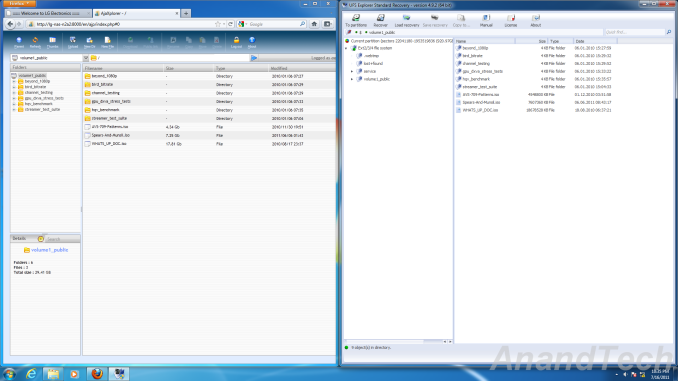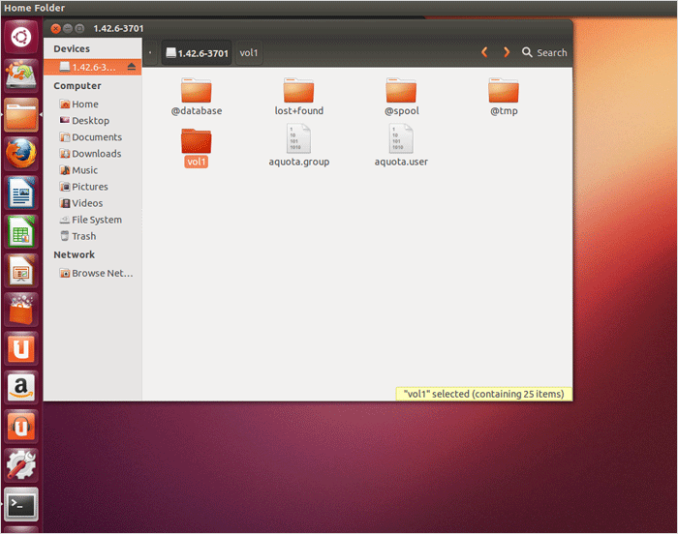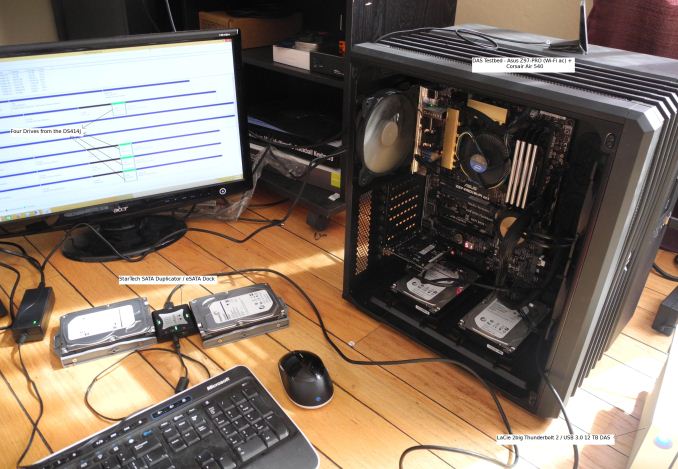Recovering Data from a Failed Synology NAS
by Ganesh T S on August 22, 2014 6:00 AM ESTData Recovery - Evaluating Software & Hardware Options
Given the failure symptoms (and the low probability of all the four hard drives in the DS414j failing at the same time), I was cautiously optimistic of recovering the data from the drives. One option would have been to put the four drives in another DS414j (or another 4-bay Synology NAS unit) and hoping disk migration would work. However, with no access to such a unit, this option was quickly ruled out.
In many of our NAS reviews, I had seen readers ask questions about data recovery from the units using standard PCs. In the review of the LG N2A2 NAS, I had covered data recovery from a mdadm-based RAID-1 volume disk member using UFS Explorer Standard Recovery v4.9.2. Since then, I have tended to prefer open source software while keeping ease of use in mind.
Recovering RAID-1 Data using UFS Explorer Standard Recovery
Searching online for data recovery options for a failed Synology NAS didn't yield any particularly promising results for Windows users. From an open source perspective, Christophe Grenier's TestDisk appeared to be able to perform the task. However, with no full featured GUI and / or instructions for recovery in this particular case (4-disk RAID-5 volume), I fell back upon UFS Explorer for a quicker turn-around. My only worry was that I hadn't used standard RAID-5 while creating the volume, but Synology Hybrid RAID (SHR) with 1-disk fault tolerance. Though it was effectively RAID-5 with the 4x 2TB drives in the NAS, I wasn't completely sure whether the software would recognize the RAID volume.
Synology does have a FAQ entry covering this type of unfortunate event for users willing to work with Ubuntu. This involves booting Ubuntu on a PC with the drives connected, installing mdadm and using that to recognize the RAID volume created by the Synology NAS.
Data Recovery from Synology NAS Drives using Ubuntu
The pros and cons of the two data recovery software alternatives are summarized below:
-
Windows + UFS Explorer
- Pro - Intuitive and easy to use / minimal effort needed for users running Windows on the relevant PC
- Con - A licensed version of UFS Explorer costs around $200
-
Ubuntu + mdadm
- Pro - Free
- Con - Complicated for users without knowledge of Linux / users not comfortable with the command line
- Con - Synology's FAQ doesn't cover all possible scenarios
Evaluating the Hardware Options
UFS Explorer can take in disk images for RAID reconstruction. The hardware in my possession that came to mind immediately were our DAS testbed (the Asus Z97-PRO (Wi-Fi ac) in the Corsair Air 540 with two hot-swap bays configured) and the recently reviewed LaCie 2big Thunderbolt 2 / USB 3.0 12 TB DAS unit. My initial plan was to image the four drives one by one into the DAS and then load the images into UFS Explorer. I started the imaging of the first drive (using ODIN) and it indicated a run time of around 4.5 hours for the disk. After starting that process, I began to rummage through my parts closet and came upon the StarTech SATA duplicator / eSATA dock that we had reviewed back in 2011. Along with that, I also happened to get hold of a eSATA - SATA cable.
The Asus Z97-PRO (Wi-Fi ac) in our DAS testbed had two spare SATA slots (after using two for the hot swap bays and one each for the boot SSD and the Blu-ray drive). Now, it would have been possible for me bring out the two SATA ports and appropriate power cables from the other side of the Corsair Air 540 chassis to connect all the four drives simultaneously, but I had decided against it because of the difficulties arising due to the positioning of the SATA ports on the board (I would have considered had the ports been positioned vertically, but all six on the board are horizontal relative to the board surface). However, with the StarTech dock, I just had to connect the eSATA - SATA cable in one of the ports. There was no need to bring out the SATA power cables from the other side either (the dock had an external power supply).
Click on image for component details
Our DAS testbed runs Windows with a 400 GB Seagate boot SSD as the only SATA drive permnanelty connected to it. I wasn't about to install Ubuntu / dual boot this machine for this unexpected scenario, but a live CD (as suggested in Synology's FAQ) with temporary mdadm installation was also not to my liking (in case I needed to reuse the setup / had to reboot in the process). Initially, I tried out a 'live CD with persistence' install on a USB drive. In the end, I decided to go with a portable installed system, which, unlike a persistent install, can be upgraded / updated without issues. I used a Corsair Voyager GT USB 3.0 128 GB thumb drive to create a 'Ubuntu-to-go' portable installation in which I installed mdadm and lvm2 manually.













55 Comments
View All Comments
Impulses - Friday, August 22, 2014 - link
While I generally agree with your logic (having never given my desktop up as my primary system, and being single), saying "just plug the laptop in via TB" or whatever isn't exactly a viable alternative for many users.I don't own a NAS, but it seems to me the biggest market for units are laptop dependant and/or multi-user households... When you have a couple and possibly kids each with their own laptop it's much easier to have a centralized media store in a NAS than anything directly attached.
Gigaplex - Saturday, August 23, 2014 - link
"A consumer can just buy high availability as a service (such as from Amazon services)"Not on ADSL2+ when dealing with multiple TBs of data I can't.
wintermute000 - Saturday, August 23, 2014 - link
QFTWHangFire - Friday, August 22, 2014 - link
Losing a day's work is considered acceptable in most environments. In theory yesterday (or last Friday) is fresh in everyone's mind, and the raw source material (emails, experimental data, FAXes, etc.) are still available in their original form to redo any data entry.What is interesting about the QSync situation is the cascading affect of failures. If caught early, through log examination, dashboards, whatever, true disaster can be averted. If minor issues like sync fails are allowed to continue, and RAID failure follows, say, a month later, then a month's worth of work can be lost. That is not acceptable in any environment.
Kougar - Friday, August 22, 2014 - link
Thanks for the article! I have a ~6 year old TS-409 Pro that is still running great, but internal component failure has been on my mind for awhile now. I'll be bookmarking this in case I ever need to use recovery options on it as I wasn't aware of either of these tools!kmmatney - Friday, August 22, 2014 - link
Nice article! I use a WHS 2011 server, with Stablebit DrivePool for redundancy. The nice thing about Drivepool is that the drives are kept in standard NTFS format. You can just take the drive out, and plug it into any computer to retrieve files, so data recovery is a piece of cake.Impulses - Friday, August 22, 2014 - link
Shame WHS is now RIPDanNeely - Friday, August 22, 2014 - link
Yeah. I'm really hoping ZFS or Btrfs NASes (without huge price premiums) will be available in the next year and a half as reasonable replacements for my current WHS 2011 box.Impulses - Friday, August 22, 2014 - link
That'd be nice, I never bought my own but I recommended and set up several for various clients & family members with small businesses...No clue what I'd tell them to migrate to right now if one were to break down, the ease of recovery and expansion was one of the biggest draws to WHS and in fact the reason many picked it over cheaper NAS boxes.
Gigaplex - Saturday, August 23, 2014 - link
There's a reason it was killed off. It has some serious design flaws that trigger data corruption, and Microsoft couldn't figure out how to resolve them. It has great flexibility but I wouldn't trust it with my data.